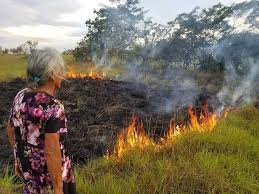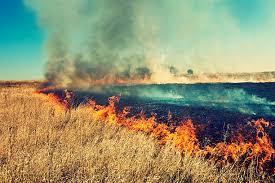Burning Grass is when the grass in fields or meadows catches fire. This can happen because of different reasons. Sometimes, people intentionally set fire to the grass, and this is called a controlled burn. Other times, the fire starts naturally due to lightning or other sources of heat.
When the grass catches fire, it can spread quickly. The flames move from one patch of grass to another, consuming everything in their path. The sight of burning grass can be both mesmerizing and dangerous. The flames dance and flicker, creating a fiery spectacle.
But why do people set fire to grass on purpose? Controlled burns have several benefits. They help clear away dead plants and debris, making space for new plants to grow. Burning also helps return nutrients to the soil, making it healthier for future plant growth. In some places, controlled burns are used to prevent larger and more dangerous wildfires by reducing the amount of dry grass and other flammable materials.
However, burning grass can also have negative effects. It can harm wildlife that lives in the grassy areas. Animals might lose their homes or even their lives in the fire. The smoke from burning grass can also pollute the air and make it difficult to breathe. It’s important to carefully plan and manage controlled burns to minimize these negative impacts.
People have been using controlled burns for a long time. Indigenous communities around the world have practiced this technique to maintain the health of their lands. Nowadays, scientists and land managers work together to decide when and where to do controlled burns. They consider the weather, the type of grass, and the needs of the ecosystem.
In some cases, burning grass is not intentional. Lightning strikes can ignite grass and start a wildfire. Wildfires are dangerous because they can spread quickly and cause a lot of damage. Firefighters work hard to control and put out these fires to protect people, animals, and property.
Furthermore, burning grass can serve both positive and negative purposes. Controlled burns help ecosystems thrive, but they need to be managed carefully. Wildfires, on the other hand, can be destructive and require quick action to stop them. Whether intentional or accidental, burning grass is a powerful force of nature that reminds us of the delicate balance between humans and the environment.
Read Also: 20 Medicinal Health Benefits of Momordica balsamina (Balsam Apple)
Advantages of Burning Grasses

Burning grasses can offer several advantages when done in a controlled and planned manner:
1. Clearing Dead Plant Material: Burning grass helps remove dead plants, leaves, and other debris from the area. This allows sunlight to reach the ground and encourages the growth of new plants. It also reduces the risk of these materials accumulating and becoming fuel for uncontrolled wildfires.
2. Nutrient Recycling: The ashes left behind after burning grass contain nutrients that are returned to the soil. These nutrients enrich the soil and promote the growth of healthier plants. This natural process mimics the cycle of nutrients found in natural ecosystems.
3. Weed Control: Controlled burns can help control the growth of invasive weeds and unwanted plants. Certain plants that are adapted to fire may thrive after a burn, while others may be suppressed, creating a more balanced and diverse plant community.
4. Habitat Restoration: In some ecosystems, regular fires are a natural part of the environment. Many native plants and animals have adapted to fire, and controlled burns can restore the health of these ecosystems by promoting the growth of fire-adapted species.
5. Wildlife Habitat Improvement: Burning grasslands can create a patchwork of different habitats, with areas of varying vegetation density. This diversity can benefit a wide range of wildlife species, providing them with food, shelter, and breeding grounds.
6. Fire Prevention: By removing excess dry grass and other flammable materials, controlled burns can reduce the risk of more intense and damaging wildfires. This can be especially important in areas prone to wildfires, as controlled burns create firebreaks that help slow the spread of larger fires.
7. Enhancing Grazing Areas: In some places, controlled burns are used to improve grazing areas for livestock. Burning can remove tough and unpalatable vegetation, making way for more nutritious grasses and plants that animals prefer to eat.
8. Promoting Biodiversity: Controlled burns can prevent the dominance of certain plant species and encourage the growth of a variety of plants. This diversity can support a wider range of animals and insects, contributing to a healthier and more resilient ecosystem.
9. Reducing Pest Populations: Burning can reduce the populations of certain pests and disease-carrying insects, as their habitats are disrupted and their populations are temporarily reduced.
10. Cultural and Traditional Practices: In some cultures, controlled burns have been used for centuries as a way to manage landscapes and promote certain plants. These practices can help maintain cultural connections to the land and its history.
It’s important to note that the advantages of burning grasses depend on various factors, including the ecosystem type, the timing and frequency of burns, and proper planning and execution. Uncontrolled or poorly managed burns can have negative consequences, so careful consideration and collaboration with experts are essential.
Read Also: Strawberry Petioles: Economic Importance, Uses and By-Products
Disadvantages of Burning Grasses

Here are some of the potential disadvantages of burning grasses:
1. Air Pollution: Burning grasses releases smoke and particulate matter into the air, which can contribute to air pollution. This can have negative effects on air quality, leading to respiratory issues and other health problems for humans and animals.
2. Harm to Wildlife: Unintentional fires or poorly managed controlled burns can harm or kill wildlife, including birds, insects, and small mammals. Animals might lose their habitats, become disoriented, or be unable to escape from the flames.
3. Loss of Biodiversity: If not carefully planned, burning can lead to the loss of certain plant and animal species that are not adapted to fire. This can result in a decrease in biodiversity and disrupt the natural balance of ecosystems.
4. Soil Erosion: After a burn, the exposed soil can be more susceptible to erosion, especially in areas with steep slopes or heavy rainfall. This can lead to soil degradation and decreased water quality in nearby water bodies.
5. Loss of Soil Nutrients: While controlled burns return some nutrients to the soil, intense fires can actually lead to the loss of nutrients as they are carried away by the wind or washed away by rain.
6. Negative Aesthetic Impact: For those who value the visual beauty of natural landscapes, the sight of burned areas might be unappealing and considered unsightly.
7. Risk to Property: Uncontrolled fires or poorly managed burns can threaten nearby homes, infrastructure, and property. Wind can carry sparks and embers, causing fires to spread beyond the intended burn area.
8. Health Risks for Firefighters: Firefighters and those involved in managing controlled burns face physical risks from the fire itself, as well as exposure to smoke, heat, and hazardous materials.
9. Impact on Cultural Sites: In some cases, burning grasslands might harm cultural sites, artifacts, or historical landmarks that hold significance to indigenous communities or local cultures.
10. Loss of Carbon Sequestration: Grasslands can act as carbon sinks, capturing and storing carbon dioxide from the atmosphere. Burning releases this stored carbon back into the air as carbon dioxide, contributing to greenhouse gas emissions.
11. Loss of Aesthetic Value: Natural landscapes and recreational areas might lose their aesthetic value if they are frequently subjected to controlled burns, affecting people’s enjoyment of these spaces.
12. Disruption of Invasive Species: In some cases, fires can actually benefit invasive plant species that are better adapted to recolonizing burned areas than native species. This can further alter the ecosystem balance.
13. Smoke Management: The smoke generated during controlled burns can affect nearby communities and roadways, leading to visibility issues and potential road accidents.
Balancing the advantages and disadvantages of burning grasses requires careful consideration and planning. It’s important to involve experts, ecologists, and local communities to make informed decisions that prioritize both the health of the ecosystem and the well-being of people and wildlife.
Read Also: Guide to Proper Physical Products & Services Distribution Tasks
